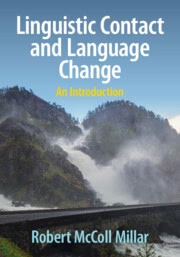Linguistic Contact and Language Change : An Introduction
- Unit price
- / per
-
Author:MILLAR Robert McColl
-
ISBN:9781009069090
-
Publication Date:December 2024
-
Edition:1
-
Pages:218
-
Binding:Paperback
-
Publisher:Cambridge University Press
-
Country of Publication:United Kingdom


A Back Order button means that we don’t have the book in stock at our store. It may already be on order – or we can order it for you from a publisher or distributor at no additional cost.
As we source items from around the globe, a back-order can take anywhere from 5 days to several weeks to arrive, depending on the title.
To check how long this might take, you’re welcome to contact us and we can provide an ETA or any other information you need. We recommend checking the timeframe before committing to an online order.
Linguistic Contact and Language Change : An Introduction
- Unit price
- / per
-
Author:MILLAR Robert McColl
-
ISBN:9781009069090
-
Publication Date:December 2024
-
Edition:1
-
Pages:218
-
Binding:Paperback
-
Publisher:Cambridge University Press
-
Country of Publication:United Kingdom
Description
Linguistic contact is a reality of everyday life, as speakers of different languages come into contact with one another, often causing language change. This undergraduate textbook provides a means by which these processes, both modern and historical, can be analysed, based on cutting-edge theoretical and methodological practices. Chapters cover language death, the development of pidgins and creoles, linguistic convergence and language contact, and new variety formation. Each chapter is subdivided into key themes, which are supported by diverse and real-world case studies. Student learning is bolstered by illustrative maps, exercises, research tasks, further reading suggestions, and a glossary. Ancillary resources are available including extra content not covered in the book, links to recordings of some of the language varieties covered, and additional discussion, presentation and essay topics. Primarily for undergraduate students of linguistics, it provides a balanced, historically grounded, and up-to-date introduction to linguistic contact and language change.
Adding product to your cart
You may also like
A Back Order button means that we don’t have the book in stock at our store. It may already be on order – or we can order it for you from a publisher or distributor at no additional cost.
As we source items from around the globe, a back-order can take anywhere from 5 days to several weeks to arrive, depending on the title.
To check how long this might take, you’re welcome to contact us and we can provide an ETA or any other information you need. We recommend checking the timeframe before committing to an online order.
You may also like
You may also like
-
Linguistic contact is a reality of everyday life, as speakers of different languages come into contact with one another, often causing language change. This undergraduate textbook provides a means by which these processes, both modern and historical, can be analysed, based on cutting-edge theoretical and methodological practices. Chapters cover language death, the development of pidgins and creoles, linguistic convergence and language contact, and new variety formation. Each chapter is subdivided into key themes, which are supported by diverse and real-world case studies. Student learning is bolstered by illustrative maps, exercises, research tasks, further reading suggestions, and a glossary. Ancillary resources are available including extra content not covered in the book, links to recordings of some of the language varieties covered, and additional discussion, presentation and essay topics. Primarily for undergraduate students of linguistics, it provides a balanced, historically grounded, and up-to-date introduction to linguistic contact and language change.
-
-
Author: MILLAR Robert McCollISBN: 9781009069090Publication Date: December 2024Edition: 1Pages: 218Binding: PaperbackPublisher: Cambridge University PressCountry of Publication: United Kingdom
Linguistic contact is a reality of everyday life, as speakers of different languages come into contact with one another, often causing language change. This undergraduate textbook provides a means by which these processes, both modern and historical, can be analysed, based on cutting-edge theoretical and methodological practices. Chapters cover language death, the development of pidgins and creoles, linguistic convergence and language contact, and new variety formation. Each chapter is subdivided into key themes, which are supported by diverse and real-world case studies. Student learning is bolstered by illustrative maps, exercises, research tasks, further reading suggestions, and a glossary. Ancillary resources are available including extra content not covered in the book, links to recordings of some of the language varieties covered, and additional discussion, presentation and essay topics. Primarily for undergraduate students of linguistics, it provides a balanced, historically grounded, and up-to-date introduction to linguistic contact and language change.
-
Author: MILLAR Robert McCollISBN: 9781009069090Publication Date: December 2024Edition: 1Pages: 218Binding: PaperbackPublisher: Cambridge University PressCountry of Publication: United Kingdom
-



